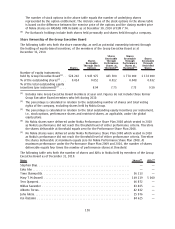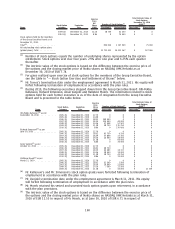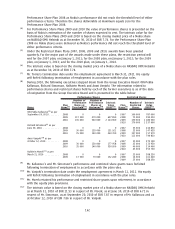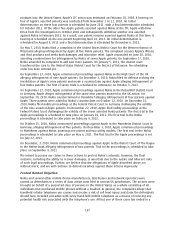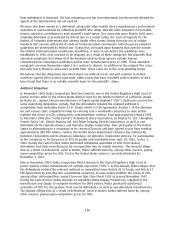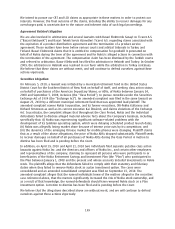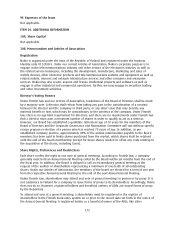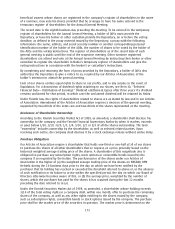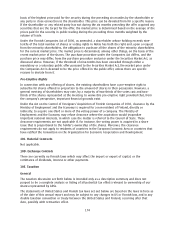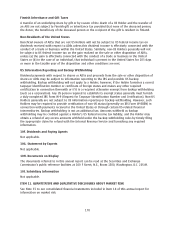Nokia 2010 Annual Report Download - page 169
Download and view the complete annual report
Please find page 169 of the 2010 Nokia annual report below. You can navigate through the pages in the report by either clicking on the pages listed below, or by using the keyword search tool below to find specific information within the annual report.final withdrawal or dismissal. The last remaining case has been dismissed, but the period allowed for
appeal of the dismissal has not yet expired.
We have also been named as a defendant along with other mobile device manufacturers and network
operators in seven lawsuits by individual plaintiffs who allege that the radio emissions from mobile
phones caused or contributed to each plaintiff’s brain tumor. Five cases that were filed in 2001 were
originally dismissed as preempted by federal law. In a recent ruling, the Court of Appeals for the
District of Columbia determined that adverse health effect claims arising from the use of cellular
handsets that operate within the US Federal Communications Commission radio frequency emission
guidelines are preempted by federal law. Claims that are based upon handsets that operate outside
the Federal Communications Commission Guidelines, or were in use before the guidelines were
established in 1996, may continue to be litigated. As a result of these rulings the five plaintiffs filed
amended complaints that allege that the handsets used by them operate outside Federal
Communications Commission guidelines and/or were manufactured prior to 1996. Those amended
complaints are now themselves subject to a motion to dismiss. In addition to the original five cases,
two new nearly identical cases were recently filed. Those cases are in the early pleading stages.
We believe that the allegations described above are without merit, and will continue to defend
ourselves against these actions vigorously. Other courts that have reviewed similar matters to date
have found that there is no reliable scientific basis for the plaintiffs’ claims.
Antitrust Litigation
In November 2009, Nokia Corporation filed two lawsuits, one in the United Kingdom’s High Court of
Justice and the other in the United States District Court for the Northern District of California, joined
by Nokia Inc., against certain manufacturers of liquid crystal displays (“LCDs”). Both suits concern the
same underlying allegations, namely, that the defendants violated the relevant antitrust or
competition laws (including Article 81 EC Treaty, Article 53 EEA Agreement, Section 1 of the Sherman
Act and various state competition laws) by entering into a worldwide conspiracy to raise and/or
stabilize the prices of LCDs, among other anticompetitive conduct, from approximately January 1996
to December 2006 (the “Cartel Period”). Defendants Sharp Corporation, LG Display Co. Ltd., Chunghwa
Picture Tubes, Ltd., Hitachi Displays Ltd. and Epson Imaging Devices Corporation, as well as non
defendant Chi Mei Optoelectronics, and Hannstar Display Corporation, have pled guilty in the United
States to participating in a conspiracy to fix certain LCD prices and have agreed to pay fines totaling
approximately USD 900 million. Further, the United States Department of Justice has indicted AU
Optronics Corporation and its American subsidiary, AU Optronics Corporation America, for participation
in the conspiracy to fix the prices of TFTLCD panels sold worldwide from Sept. 14, 2001, to Dec. 1,
2006. During the Cartel Period, Nokia purchased substantial quantities of LCDs from several
defendants and other manufacturers for incorporation into its mobile handsets. The lawsuits allege
that as a result of defendants’ cartel activities, Nokia suffered harm by, among other reasons, paying
supracompetitive prices for LCDs. Trial in the United States action is currently scheduled for
November 1, 2012.
Also in November 2009, Nokia Corporation filed a lawsuit in the United Kingdom’s High Court of
Justice against certain manufacturers of cathode rays tubes (“CRTs”). In this lawsuit, Nokia alleges that
the defendants violated the relevant antitrust or competition laws (Article 81 EC Treaty and Article 53
EEA Agreement) by entering into a worldwide conspiracy to raise and/or stabilize the prices of CRTs,
among other anticompetitive conduct, from no later than March 1995 to around November 2007.
During the Cartel Period, Nokia, through its subsidiary Nokia Display Products Oy, engaged in the
manufacture and supply of computer monitors for third parties. Nokia purchased substantial
quantities of CRTs for this purpose from several defendants, as well as nondefendant manufacturers.
The lawsuit alleges that as a result of defendants’ cartel activities, Nokia suffered harm by, among
other reasons, paying supracompetitive prices for CRTs.
168


